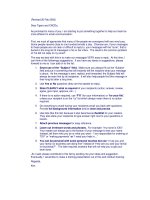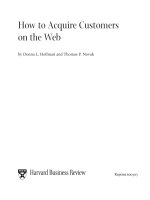Tài liệu HOW TO THINK LIKE BENJAMIN GRAHAM AND INVEST LIKE WARREN BUFFETT PART 8 ppt
Bạn đang xem bản rút gọn của tài liệu. Xem và tải ngay bản đầy đủ của tài liệu tại đây (148.46 KB, 37 trang )
205
C hapter 13
DIRECTORS AT
WORK
A
n increasingly common lament sung across corporate America
is that directors are overworked. They are asked to do too much,
must satisfy too many competing interests, and so on. There is a
simple and sufficient solution to this condition. Directors should be
asked to do a short list of five things and do them well. The key jobs
entrusted to any board of directors are as follows:
• Selecting an effective chief executive
• Setting executive compensation
• Evaluating takeovers
• Allocating capital
• Promoting integrity in financial reporting
Effective performance of these jobs ultimately depends not so
much on governance mechanisms as on board trustworthiness. An
investor should pay attention to how well directors perform these
tasks as a way to gauge where along the continuum from owner
orientation to manager orientation they sit. A management-oriented
position is suggested by fat executive paychecks for a dismal perfor-
mance. A stakeholder-oriented position reveals itself in poor returns
on invested capital that keep unproductive plants operating in a bow
to labor pressure. An owner orientation is reflected by good perfor-
mance, reasonable executive pay, and the cultivation of productive
workers in productive jobs.
As a management orientation example, ask yourself whose inter-
ests were really going to be served by AMP’s resistance to Allied-
Signal’s bid discussed in Chapter 11? AMP’s shareholders objected,
and so they obviously thought their interests were being disserved,
and AMP’s plan to boost the company’s profitability included cutting
Copyright 2001 The McGraw-Hill Companies, Inc. Click Here for Terms of Use
206
In Managers We Trust
the work force by about 9%, or 4200 jobs, and closing ten factories.
1
AMP’s board ultimately may have served the corporation’s interests
in concluding a deal with a friendly partner, but AMP’s CEO and
management undoubtedly pressured the board to resist what by all
accounts looked good for shareholders in favor of something that
looked bad for the workers.
The best way to tell where a company sits is to investigate the
way its directors tackle their key jobs. Focus on those jobs and decide
which boards do them well.
HAIL TO THE CHIEF
The CEO sets the tone at the top. The CEO’s historical performance
on matters such as compensation, acquisitions, and capital alloca-
tion generally is the key question an investor should ask when judg-
ing a CEO and deciding whether to entrust wealth to his or her
management. Special attention must be paid to selecting a CEO
because of his or her unique role in the organization.
Warren Buffett notes that standards for measuring a CEO’s per-
formance are either inadequate or easy to manipulate, and so a
CEO’s performance is harder to measure than that of most workers.
The CEO has no senior other than in theory the company’s board
of directors. That board is often handicapped in its performance
review, however, because of a lack of measurement standards and
because as meetings come and go, the relationship between the CEO
and the directors increasingly becomes congenial rather than super-
visory.
Maintaining that supervisory attitude is critical. The board’s role
in reviewing the CEO’s performance is most acute precisely where
it can be most easily impaired: dealing with a mediocre manager. It
is easy for a board to get rid of a terrible manager; the hard case is
a so-so one. Recruiting the top talent and a roster of succession
candidates is a critical board function. Too often the importance of
this role is overlooked, as occurs when a board simply replaces an
outgoing CEO with the number two fellow at the company (which
happens about two-thirds of the time). This means that many boards
fail to evaluate changing organizational needs and variations in the
personal talents of the two at the top.
2
Abdication of a board’s responsibility for CEO selection is most
clear when a board simply allows an incumbent CEO to handpick
Directors at Work
207
the successor. There is little reason to believe that even the most
outstanding CEO is as good as a top board at picking a new CEO.
The result is too often the need to oust the new CEO pretty early
in his or her tenure.
Still, boards must evaluate a CEO’s performance regularly and
out of the CEO’s presence, and evaluating that performance is hard-
er than it seems. Both short-term results and potential long-term
results must be assessed. If only short-term results mattered, many
managerial decisions would be much easier, particularly those relat-
ing to businesses whose economic characteristics have eroded.
Recall again Al Dunlap’s aggressive and doomed plan to turn
around the ailing Sunbeam. The huge accounting scandal that fol-
lowed in its wake also suggests its inherent stupidity. Once it was
clear that Dunlap was a terrible manager, it was easy for the Sun-
beam board to throw him out, but before the fallout he looked at
worst mediocre and therefore harder to disagree with.
PAY
Plenty of evidence shows that the total level of executive compen-
sation in the United States is positively correlated with the level of
corporate performance. Some evidence even shows a positive cor-
relation between performance and the portion of total compensation
paid in stock.
3
Even so, it is also obvious that some executives are paid sub-
stantially more than they should be in light of their performance.
Accordingly, investors should pay close attention to potentially pi-
ratical executive compensation.
Compensation Levels
This is not to say that it is desirable to have governance rules that
limit top executive compensation to some ratio of the pay of the
least compensated employee at a company. Indeed, Ben & Jerry’s
tried this during its early years of business life, capping its founder’s
and chief’s compensation at seven times that of the lowest-paid
worker. But once the company outgrew its founder’s managerial
skills, it was forced to go on the market to recruit top talent, and
that required a pay package way higher than that cap.
4
208
In Managers We Trust
If the early Ben & Jerry’s policy showed bad judgment, some of
the pay packages seen lately show something far worse. The CEO
of Network Associates (owner of the McAfee computer antivirus pro-
grams), for example, got about $7 million in shares of McAfee.com
just ahead of its IPO even though the business of Network Associ-
ates performed poorly and McAfee itself was losing money.
5
A key issue in the merger between Chrysler and Daimler-Benz
was the enormous difference between the two companies both in
the level of executive compensation and in the compensation ratios
of the highest-paid and lowest-paid employees. In 1997, for example,
Robert Eaton, Chrysler’s chairman of the board, received total com-
pensation of about $10 million, over 200 times the average worker’s
pay and nearly as much as the total compensation paid to all ten
members of Daimler-Benz’s management board combined. Daimler-
Benz’s chairman, Jurgen Schrempp, was paid about one-tenth as
much as Eaton, making his compensation approximately twenty
times that of the average Daimler-Benz worker.
Thus, a major question in the merger was the form that the
combined entity’s compensation structure should take. Schrempp
pointed out that the existing pay differences reflected cultural dif-
ferences, particularly the somewhat more egalitarian corporate cul-
ture in Germany, as demonstrated by labor representation on super-
visory boards. He also predicted that the U.S. model would prove to
be the proper form for DaimlerChrysler and other transnational
companies, except that “the only way to make big pay packets so-
cially acceptable is by linking them closely to performance.”
6
Schrempp’s statement mirrors the rhetoric of corporate America.
Given that the other differences in corporate governance between
Germany and the United States are more nuanced and subtle than
is generally understood, you have to wonder if this was Schrempp’s
main point when he said that DaimlerChrysler created “the first
German company with a North American culture.” Any doubt was
cleared up when Schrempp subsequently proselytized for American-
style executive options at DaimlerChrysler’s April 2000 shareholder
meeting, something his German shareholders sensibly resisted.
Stock Options
A decade ago corporate governance mavens urged boards to pay
managers more in stock than in cash to promote an alignment of
interests between managers and shareholders. The response was tre-
Directors at Work
209
mendous, a bit like the apocryphal story of Lady Astor’s famous quip
on the Titanic: “I asked for ice, but this is ridiculous.”
What the governance gurus got was a proliferation of payment
not in stock that was the functional equivalent of the forgone cash
but instead stock options with a value vastly exceeding what the cash
payment could reasonably have been. The explosion of option-based
compensation remains one of the most controversial subjects in cor-
porate governance history.
Some say that the widespread use of stock options in the United
States simply reflects the priority given to this alignment goal in the
United States and that its relative infrequency in Europe and else-
where reflects the absence or irrelevance of this goal. However, the
talk of alignment is more myth than truth and too often represents
an attempt to sanitize management compensation packages that con-
flict with shareholder interests (not to mention labor interests).
Stock Option Myths
No evidence indicates that the prevailing structure of executive com-
pensation in the United States comes anywhere close to aligning
manager and shareholder interests. On the contrary, a great deal of
evidence demonstrates that the compensation structure is random.
Many corporations give their managers stock options which in-
crease in value simply through earnings retention, rather than be-
cause of improved performance resulting from superior deployment
of capital. By retaining and reinvesting net income, managers can
report annual earnings increases without doing anything to improve
real returns on capital.
Buffett makes the point: “You can get the same result personally
while operating from your rocking chair. Just quadruple the capital
you commit to a savings account and you will quadruple your earn-
ings. You would hardly expect hosannas for that particular accom-
plishment.”
7
When that happens, stock options rob the corporation and its
shareholders of wealth and allocate the booty to the optionees. In-
deed, once granted, stock options are often irrevocable and uncon-
ditional and benefit the grantees without regard to individual per-
formance—a form of instant robbery.
Even if stock options encourage optionees to think as share-
holders would, optionees are not exposed to the same downside risks
as shareholders are. If economic performance improves and the
210
In Managers We Trust
stock price rises above the exercise price, the optionees will exercise
the option and share in the increase with shareholders. But if eco-
nomic performance is unfavorable and the stock price remains below
the exercise price, optionees simply will not exercise the option.
Shareholders suffer from the corporation’s unfavorable performance,
but an option holder does not.
These awards also exacerbate the misalignment of interests be-
tween corporate option holders (usually senior executives) and other
workers. The awards dramatically increase the compensation differ-
ential between highly paid executives and ordinary laborers, a ratio
which is significantly higher in the United States than it is in Europe
and elsewhere. Accordingly, when stock options are used, they
should be spread throughout the employee base—as GE has done—
rather than limited to the top dogs.
Stock Option Costs
The direct cost to shareholders of stock option compensation is the
dilution of their ownership interest. A common managerial response
to the dilution is to buy back outstanding shares. The trouble with
that solution is that it devours corporate funds that might be more
profitably deployed.
Shocking indirect costs are accounting rules that fail to require
employee stock options to be recorded as an expense on the income
statement.
8
This translates into earnings per share figures that over-
state actual earnings for companies with executive stock options out-
standing. Even the diluted earnings per share figure does not reflect
these costs.
Accordingly, you must adjust earnings figures for the cost of op-
tions. Doing this is not easy, however, for not all information is nec-
essarily found in the financial statements. You need to examine the
footnotes for something called overhang, which is the percentage of
the company that outstanding stock options would represent if they
were exercised. The average percentage has mushroomed from under
10% a few years ago to nearly 15% now.
Still, the actual cost of options is not presented directly, though
there is some footnote disclosure about this. The real cost equals
the price at the time of exercise minus the amount the executive
pays (the exercise price). This is the truest measure of cost because
the company could have generated that much by selling the optioned
shares to others at the prevalent price instead of at the option price.
The cost of executive stock options is substantial, averaging
Directors at Work
211
about 5% of annual earnings among S&P 500 companies and in
some cases amounting to half of reported earnings, including at Ya-
hoo!, Polaroid, and Palm.
9
In less dramatic but still striking exam-
ples, if stock options were recorded as a cost, the 1999 earnings of
some major companies would be slashed: Cisco, 24%; Microsoft,
12%; IBM, 8%; and Oracle, 16%.
10
These cost effects extend for many years, depending on the life
of the options. At many companies, options have a life of five years.
Increasingly, companies extend their lives to as long as 10 and 15
years.
Accountability
Legal rules are ill equipped to police executive compensation. The
general stance of U.S. courts is to evaluate compensation issues, if
at all, under a waste standard. This standard rarely upsets corporate
decisions. Waste requires pretty much the irrational trashing of cor-
porate assets in ways akin to dumping truckloads of cash into the
Hudson River. In the case of executive compensation, U.S. courts
are quite deferential to management indeed.
As for securities disclosure laws, the SEC requires substantial
and focused disclosure of top executive compensation in compara-
tive performance charts. Nevertheless, corporations continue to
structure executive compensation packages so that they don’t show
up in the bottom-line numbers. For example, after accounting stan-
dard setters ruled that a reduction in the exercise price of a previ-
ously issued option had to be recorded as an expense on the income
statement, many companies chose instead to extend the life of the
option.
Without effective legal or accounting regulations, the chief job
of policing executive compensation lies with the corporate board.
Board members must insist that executive compensation peg indi-
vidual contributions to corporate performance. Measuring executive
performance by business profitability is the most definitive yardstick
with regard to shareholder as well as labor interests. When measur-
ing performance, companies should reduce earnings by the capital
employed in the relevant business or by the earnings the firm retains.
Caveat
While Warren Buffett tends to share these criticisms of stock option
compensation packages, he is careful to record the following caveat:
212
In Managers We Trust
Some managers whom I admire enormously—and whose oper-
ating records are far better than mine—disagree with me re-
garding fixed-price options. They have built corporate cultures
that work, and fixed-price options have been a tool that helped
them. By their leadership and example, and by the use of options
as incentives, these managers have taught their colleagues to
think like owners. Such a culture is rare and when it exists
should perhaps be left intact—despite inefficiencies and ineq-
uities that may infest the option program.
11
Investors should look for boards that take the lead in policing
stock option compensation, but beware—they are scarce.
DEALS
Just as the disease of random executive compensation must be
avoided by intelligent investors and trustworthy boards, so must the
costs of imprudent acquisition policies and defensive tactics.
Offensive
Offensive acquisition strategies require careful board attention be-
cause of the strong possibility that even outstanding senior managers
possess individual interests that conflict with owner interests. Ac-
quisitions give CEOs enormous psychological benefits by expanding
their dominion and generating more action. Acquisitions driven by
these sorts of impulses come at shareholder expense.
Most acquisitions do not achieve gains in business value. A 1999
study by the global accounting firm KPMG concluded that “83% of
mergers [during the period 1996–1998, when trillions had been paid
in merger deals] failed to produce any benefits for shareholders and,
even more alarming, over half actually destroyed value.” That study
also found, based on interviews with managers involved in mergers,
that less than half did any postdeal review to test whether value was
added or subtracted!
12
A governance problem exists because most acquisition attempts
do not come to the board for discussion until the process is sub-
stantially under way and until after the CEO has invested substantial
personal capital in them. Rejecting an acquisition proposal after the
CEO invests substantial personal capital is often considered a rejec-
tion of the CEO who presented the proposal to the board. This prob-
lem is especially acute among CEOs who resent hearing bad news.
Directors at Work
213
Cascades of stupid acquisitions come pouring in, often drowning the
board’s better judgment.
These timing problems make it difficult to design a governance
mechanism that would alleviate this pressure on the board. The ego
problems are just as intractable, as another Buffettism suggests:
“While deals often fail in practice, they never fail in projections—if
the CEO is visibly panting over a prospective acquisition, subordi-
nates and consultants will supply the requisite projections to ration-
alize any price.”
13
Mattel, for example, is a worldwide leader in the design, man-
ufacture, and distribution of toys. In May 1999 it bought the Learn-
ing Company, a producer of educational software for personal com-
puters. Mattel paid for the $3.8 billion purchase by using Mattel
stock at a time when the stock was trading at about $26 a share
(down already from an average trading price over the prior year of
around $40). Mattel’s chair, Jill Barad, announced in July 1999 that
the Learning Company was contributing to Mattel’s overall opera-
tions with “exceptionally strong growth” in revenues and margins and
said this “was one of the reasons this merger made so much sense
for Mattel.”
14
Barad did not say how the computer software business related
to Mattel’s traditional products, such as Barbie dolls, Fisher-Price
toys, and Hot Wheels. But just three months later, in October
1999, Mattel announced that the Learning Company division’s rev-
enues had declined and it had lost money because of, among other
things, higher than expected product returns from customers and
write-offs of bad debts.
15
Instead of earning $50 million that quar-
ter as Barad estimated, it lost over $100 million, and Mattel’s stock
plummeted to about $11 a share. Many analysts, at least in hind-
sight, reported that these problems at the Learning Company were
not new and should have been uncovered and discounted before
Mattel bought it.
These analysts also thought that Mattel fit the description of a
company about to make a bad acquisition. If sales growth in your
core business is declining and you can’t seem to do anything about
it through product, marketing, or distribution improvements, one
impulse is to buy yourself some growth through an acquisition. Mat-
tel’s sales growth, incidentally, was declining in its core products
right before the Learning Company acquisition. So too, for that mat-
ter, was the Learning Company’s. (Mattel’s board ousted Barad in
early 2000, awarding her an exorbitant severance package, and re-
placed her with Kraft Foods CEO Robert Eckert.)
214
In Managers We Trust
Contrast Mattel’s story with the policies of Disney. Disney’s
philosophy is to make only acquisitions that are in a related or
complementary field that current management understands fully,
and at a fair price. In its most important acquisition, Capital Cities
ABC fit the bill. Disney’s long-time chairman, Michael Eisner, had
worked at ABC from 1966 through 1976 and had seen it grow from
a network critics called the “fourth of three” to first place in every
category.
After Capital Cities bought ABC in 1986, Tom Murphy and Dan
Burke catapulted it to yet new heights, and the combination with
Disney made sense. Walt Disney himself liked ABC as well. After
all, ABC helped finance Disneyland in 1955, and Walt brought ABC
to Hollywood when he began what is now The Wonderful World of
Disney. Disney’s Internet business benefited enormously from the
addition of ABC.com, ESPN.com, and a host of cable assets that
enable important growth opportunities.
Defensive
Takeover defenses are the flip side of offensive acquisition strategies.
Antitakeover devices such as the poison pill protect management’s
decision making by discouraging attempts to acquire the corporation
or remove incumbent directors (as AMP’s defense against Allied-
Signal attests). If some or a majority of stockholders deem a takeover
attempt to be in the corporation’s and their best interest and the
potential acquirer is willing to pay a premium over the prevailing
market price or intrinsic value of the corporation’s common stock,
antitakeover devices work against shareholders.
Disney’s acquisition philosophy is also illustrative on this side of
the table. Corporate raiders of the early 1980s sought to acquire
Disney and bust it up but Roy Disney would not let that happen.
He preserved Disney as a great American institution and facilitated
a recommitment to the fundamental businesses that had made it
great. Disney animation, for example, with Roy at the helm, rein-
vented itself and surged with a long series of critically and popularly
acclaimed films. In doing so, Disney adopted the best takeover de-
fense strategy there is: an extraordinary business. (More on Disney
in the next chapter.)
To be sure, situations exist in which hostile offers are inadequate
and not in the interests of the corporation or any of its constituents.
Yet incumbent managers facing unwanted takeover talks naturally
Directors at Work
215
will resist the efforts of the acquiring firm whether or not their re-
sistance best serves the corporation. After all, in most cases their
jobs are at risk.
Within U.S. corporations—and probably increasingly within cor-
porations organized elsewhere—takeovers put unmatured stock op-
tions at risk. Faced with this prospect, managers may employ mech-
anisms designed to resist inferior bids in an effort to resist superior
bids. They thus may use a poison pill against a bid that is great for
shareholders when it should be used only to deter bids that are bad
for shareholders.
In these situations, boards must recognize that CEOs and their
troops are under fire, just as they are when a board challenges one
of their proposed offensive acquisitions.
In both situations boards should expect managers to adopt a
siege mentality which obscures honest thinking about what is in the
owners’ interests. In both offensive and defensive situations there is
no clear mechanism that can assure that boards will respond prop-
erly, but boards must at least recognize what is happening psycho-
logically in these situations if they hope to respond effectively at all.
For investors, identifying directors with that capacity is key.
CAPITAL
A company generating substantial amounts of excess cash can deploy
it in one of four ways. It can reinvest in the business, repurchase its
own shares, distribute the cash in dividends to shareholders, and, as
was just noted, make acquisitions.
Aside from a few formal and manipulable limits, U.S. law gives
boards of directors unbridled discretion in the choice of these uses,
including declaring and paying dividends and making or not making
repurchases. Corporate charters rarely restrict dividend policies, al-
though a corporation’s loan and credit agreements sometimes do.
The policy of most U.S. boards is to pay regular quarterly cash
dividends at a stable or steadily increasing dollar amount. This pat-
tern is inconsistent with the reality that underlying business perfor-
mance is hardly ever that smooth. Earnings are almost always bumpy
(even if less bumpy than average stock prices).
Dividends tend to be way higher than they should be. Given the
importance of dividend policy in capital allocation decisions, certain
common reasons that boards use to justify their policies, such as
216
In Managers We Trust
signaling confidence and giving the appearance of reliability, are ei-
ther strange or disingenuous.
We should give credit to boards that use a more rigorous ap-
proach for setting dividend policy, an ideal set forth by Warren Buf-
fett. The test distinguishes between restricted earnings, those which
must be reinvested in a business just to maintain its competitive
position, and unrestricted earnings, which should be retained only
when there is a reasonable prospect that for every dollar retained,
at least one dollar of market value will be created for shareholders;
otherwise, the dollar of earnings should be paid out.
16
Microsoft fol-
lows this policy pretty well, never having paid a dividend and gen-
erating great returns on the reinvested capital.
Boards can justify retaining earnings under this test only if the
capital retained produces incremental earnings at least equal to the
return generally available to the shareholders. For companies that
can reinvest earnings in this manner, dividends should not be paid
and boards should ignore any negative signals this policy sends, such
as lack of confidence or unreliability (though they should pay atten-
tion to the resulting tax advantages to shareholders).
The smartest thing a company can do with undervalued stock is
to buy it back. Obviously, if a stock is selling in the market at half
its intrinsic value, the company can buy $2 in value by paying $1 in
cash. You rarely find better uses of capital than that. Stock repur-
chases usually give a stockholder a slight tax advantage. Dividends
on common stock are taxed as ordinary income at rates as high as
39.6%, whereas income generated by the repurchase of stock held
longer than a year is treated as capital gains at rates no higher than
20%.
Stock buybacks are not always what they seem. They reduce the
number of a company’s shares outstanding, thus increasing earnings
per share. The typical result is that investors buy more of that stock
and thus bid the price up, mistakenly believing that the repurchases
are a managerial signal that the company’s stock is underpriced. Of-
ten, however, the repurchase program is a cognate of a stock issu-
ance program to offset shares issued upon the exercise of stock op-
tions. The increased stock price, after all, means increasing the value
of stock options on that stock. When a repurchase program and an
issuance program are run simultaneously, you should be more dis-
criminating in your judgment of what management is doing.
It is possible that this effect could lead management (with many
stock options at its feet) to prefer buybacks even if that were not
Directors at Work
217
the smartest way to allocate the company’s capital. Indeed, options
create incentives to borrow money for stock repurchases that boost
earnings per share and return on equity. That poses a major risk, as
a smaller equity base in a crisis can push a company closer to bank-
ruptcy, severely damaging shareholder interests (as well as the inter-
ests of others).
In contrast to the occasional wisdom of stock repurchases is the
universal folly of stock splits. Stock splits have three consequences,
none of them beneficial to the stockholders. They increase trans-
action costs by promoting high share turnover; they attract share-
holders with short-term, market-oriented views who unduly focus on
stock market prices; and, as a result of both of those effects, they
lead to prices that depart materially from intrinsic business value.
With no offsetting benefits, splitting a stock is nonsense. Nev-
ertheless, most companies do it, including GE, Microsoft, and Am-
azon.com. Berkshire Hathaway is one of the handful that don’t. After
going public in mid-1997, Amazon.com split its stock three times
from June 1998 to September 1999! GE split its stock only nine times
in its hundred-plus-year history, though three of those splits oc-
curred in the last six years of the 1990s.
The only meritorious argument favoring stock splits is that they
reduce the per share price of stock and thus enable a wider investor
group to participate. If no U.S. company in history had ever split its
stock, the per share price of some of the best companies would be
in the tens of thousands of dollars (as is the case at Berkshire Hath-
away, for example). That price level is prohibitive for many investors.
This argument does not justify the high frequency of stock splits,
however, which are used to keep prices below a couple of hundred
dollars—an amount that is affordable by all investors.
CHECKING UP
As Chapter 10 showed, for accounting information to be valuable,
users must have justifiable confidence in its integrity. Forces that
jeopardize integrity are often intractable: Business innovation, evo-
lution, and complexity, coupled with the formal nature of accounting
rules inevitably create a substantial zone of managerial discretion in
financial reporting.
Integrity in financial reporting is promoted through internal con-
trol systems and by external auditor certifications, both of which can
218
In Managers We Trust
constrain managerial discretion somewhat. For these mechanisms to
be effective, however, the board of directors must assure that both
internal controls and external audits do this.
Internal financial reporting controls are designed to assure that
transactions are executed in accordance with management policy
and are recorded properly in the accounting records (and to assure
that assets are deployed only in accordance with management pol-
icy). They range from daily journal entries that are reviewed regularly
by others, to periodic taking of inventory, to procedures for review
of judgments concerning depreciation, to the articulation and review
of risk management policies. Some of these tools are required by
federal securities laws.
Within a corporation, both the board of directors and the man-
agers play a role in defining, implementing, and evaluating internal
controls. In principle, however, the chief and ultimate responsibility
for internal controls rests with the board of directors, both as a mat-
ter of common sense and as a matter of policy. Boards have a com-
parative informational advantage and greater motivation to police
managerial opportunism than managers do. This obligation entails
supervising the design of internal control systems and supporting
their administration.
The critical importance of internal controls to the integrity of
financial reporting is evidenced by the requirement that outside au-
ditors review them in connection with annual audits of a company’s
financial statements. This audit is intended to obtain objective as-
surance that the financial statements are relevant and reliable, based
on a general review of the financial statements and the underlying
day-to-day records and periodic summaries on which they are based.
The audit is a monitoring mechanism that lends credibility to
the financial statements. For that credibility to be meaningful, how-
ever, the auditor must work closely with members of the board of
directors, and both the auditor and those directors must act with
diligence, independence, and awareness. Several challenges are
posed for a board and its audit committee.
First, an audit conducted by an independent firm does not
change the fact that a company’s management prepares the financial
statements and is responsible for them. The audit is a review of those
statements. The audit does not entail a review of every financial
transaction in which the company engaged during the period covered
by the financial statements. That is a practical impossibility for any
auditor and even more so for any audit committee. Businesses en-









